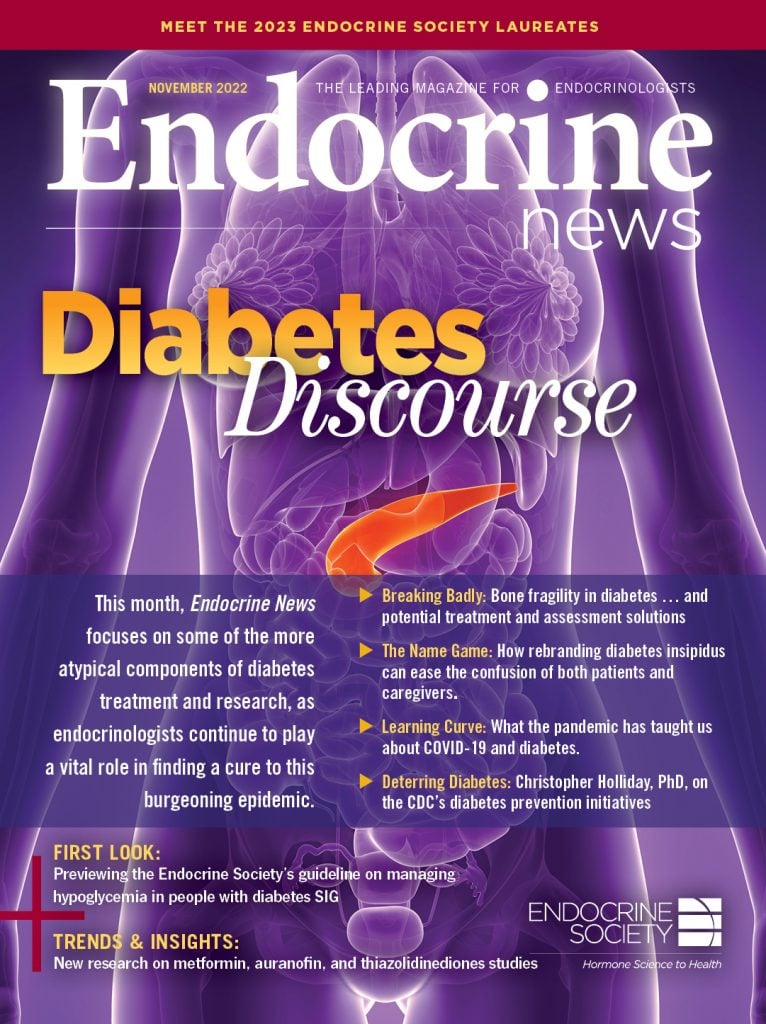
People with diabetes have an increased risk of fractures, which is often underdiagnosed and impacts their mobility as well as their mortality. A new array of treatments and assessments — novel therapeutics, senolytics, revamped prescribing protocols, and more — are needed to better concentrate on diabetic bone disease.
An emerging complication of both type 1 and type 2 diabetes is confounding clinicians and prompting new research into its pathophysiology as well as its prevention and treatment: increased fracture risk as a result of bone fragility. In older adults, this risk is compounded by the risk for falls and fractures inherent to their age.
The proposed mechanism underlying this increased risk in type 1 diabetes is relatively straightforward — because type 1 diabetes commonly manifests in childhood or adolescence before the individual has attained peak bone mass, and the insulin deficiency associated with type 1 diabetes reduces anabolic bone formation, lower overall bone mass results, predisposing the individual to fracture. But the increased risk in type 2 diabetes in individuals with normal bone mass/normal bone mineral density (BMD) poses a seeming paradox (although the risk of hypoglycemia with insulin or sulfonylureas does increase the risk of falls).
Regardless, individuals with either type of diabetes experience 32% more fractures than those without, especially of the hip. That number jumps to a five-fold higher risk in type 1 diabetes alone. Other differences include that atypical femoral fractures as seen with antiresorptive osteoporosis therapy are twice as common in type 1 diabetes, and, in type 2 diabetes, men are more at risk than women for fractures at all sites. The latter finding is as yet unaccounted for but may stem from a negative gender bias with men seeking medical care less frequently or later and having poorer lifestyle habits and a higher prevalence of cardiovascular disease.
Further confounding the situation, the gold standard for BMD measurement, dual-energy x-ray absorptiometry (DEXA), does not adequately predict fracture risk in these populations, despite its efficacy in predicting fracture risk in the setting of postmenopausal and male osteoporosis.
To get to the bottom of some of these conundrums, Professor Lorenz C. Hofbauer, MD, of the Universitätsklinikum an der Technischen Universität Dresden, in Germany, and team reviewed existing studies of individual aspects of bone health in diabetes to aggregate findings and offer a clearer overall picture in “Bone fragility in diabetes: novel concepts and clinical implications,” published in January in The Lancet Diabetes & Endocrinology. “In this Review, authors that were all members of the European FIDELIO research consortium took a comprehensive look. This included the massive progress of cell and molecular biology connecting the skeleton and diabetes, the latest imaging techniques, novel biomarkers, and recent clinical trials,” said Hofbauer. FIDELIO stands for “Training network for research into bone Fragility In Diabetes in Europe towards a personaLised medIcine apprOach.”
Pathogenesis of Bone Disease in Diabetes
Even before undertaking their review, Hofbauer and team knew that the areal 2D-measurement of DEXA does not provide precise information about actual bone strength and sought a more tailored approach to assessing and preserving bone health in these individuals. “For example,” says Hofbauer, “some newer high-resolution techniques, such as high-resolution peripheral quantitative computed tomography (HRpQCT), better depict the structural impairment at the cortical and trabecular bone compartments brought on by type 2 diabetes and bone quality aspects in general.”
Histomorphometry in diabetic bone disease reveals a variety of cellular and molecular changes, adds Martina Rauner, PhD, a Dresden-based bone biologist and senior author, including:
• Bone matrix accumulation of advanced glycation end products (AGEs) that render bone less resistant to fractures;
• Increased sclerostin and Dickkopf-1 production that inhibit Wnt signaling and as a consequence bone formation;
• Suppressed osteoblast function, impairing their ability to differentiate;
• Increased pro-inflammatory adipocytes in bone instead of osteoblasts;
• Impaired mechanosensing of osteocytes and thus repair mechanisms leading to accumulation of micro-damage;
• Osteocyte senescence that leads to reduced bone turnover;
• Cortical porosity associated with microvascular damage, leading to bone fragility; and
• Efferocytosis inhibition, leading to accumulation of apoptotic cells and a pro-inflammatory profile.
Some of these detrimental alterations provide opportunities for therapeutic or lifestyle interventions. Others are not detectable with standard techniques, thus underscoring the need for novel imaging approaches. Currently, BMD is the accepted correlate for bone strength; however, diabetes represents an exception, in which normal BMD does not reveal underlying bone fragility. Here, bone quality is a better predictor, encompassing additional factors like collagen characteristics and bone tissue mechanical properties, but better imaging tools and biomarkers are warranted.
Assessment Approaches
Hofbauer and team advise clinicians to begin with assessing diabetes-specific risk factors for bone fragility, such as disease duration; vascular complications; poor glycemic control; and treatment with sulfonylureas, thiazolidinediones, or insulin. Here, another seeming paradox emerges that Hofbauer explains this way: “Although insulin is an (osteo)-anabolic factor, and switching a patient with type 2 diabetes from a conventional insulin therapy to an intensified insulin regimen with four injections per day benefits the glycemic control and the skeleton alike, amongst the larger group of patients with type 2 diabetes, those who require insulin rather than, say, metformin or just diet, have a priori more severe type 2 diabetes and experience more frequent falls and fractures.”
“…amongst the larger group of patients with type 2 diabetes, those who require insulin rather than, say, metformin or just diet, have a priori more severe type 2 diabetes and experience more frequent falls and fractures.”
Lorenz C. Hofbauer, MD, Universitätsklinikum an der Technischen Universität Dresden, Dresden, Germany
Once a comprehensive evaluation for the presence of the above risk factors has been done, the team adopts The International Foundation of Osteoporosis’s recommendations for next steps. The most important message for clinicians, says Hofbauer, is “include bone health assessment in all patients with type 1 diabetes and patients with type 2 diabetes for more than five years.” Correct interpretation of BMD is challenging. To overcome these obstacles, the team proposes applying a “correction factor” in the FRAX score: instead of using –2.5 as the intervention threshold, in type 2 diabetes, that threshold becomes –2.0. “Large data analyses indicate that as for other secondary causes of osteoporosis, such as glucocorticoid-induced osteoporosis, diabetes also requires adjustment to obtain a refined assessment and more precise prediction of fracture risk,” explains Hofbauer. In addition, evaluation of vertebral fractures, which individuals with type 2 diabetes have a 35% higher risk for, and trabecular bone score should also be done.
Prevention and Treatment
Regarding management, diet and physical activity are key, as in any diabetes management plan. Physical activity in this setting, however, has the additional advantages of preventing sarcopenia and frailty. Furthermore, combined resistance and endurance training might lower sclerostin concentrations and improve glucose control, muscle health, and fall prevention.
“Some newer high-resolution techniques, such as high-resolution peripheral quantitative computed tomography, better depict the structural impairment at the cortical and trabecular bone compartments brought on by type 2 diabetes and bone quality aspects in general.”
Lorenz C. Hofbauer, MD, Universitätsklinikum an der Technischen Universität Dresden, Dresden, Germany
Those individuals with diabetes with serum vitamin D levels below 20 ng/mL should take vitamin D supplements to prevent bone fragility; calcium supplementation may also be warranted. The efficacy of typical anti-osteoporotic agents is unknown in this specific population, but the team found evidence that anabolic therapy such as with teriparatide, abaloparatide, or romosozumab might be of benefit. In addition, following up with antiresorptive therapy could have synergistic and sustained effects on BMD, but this has not yet been proven in individuals with diabetes.
A Word on Senolytics
Given that long-standing type 1 and type 2 diabetes are characterized by impaired bone cell activity and bone repair driven partly by increased osteocyte senescence, as demonstrated by Sundeep Khosla, MD’s team from the Mayo Clinic, some researchers have likened diabetes to accelerated aging. Enter the senolytics, a novel class of drugs that target senescent cells.
“Senescent cells can be detected in metabolic, neurodegenerative, and prototypic age-related disease, and have been preclinically linked to several metabolic bone disease, in particular bone disease due to diabetes, radiation, and periodontitis. Given their involvement in many age-related diseases, they are promising, and clinical development is ongoing,” says Hofbauer.
Horvath is a Baltimore, Md.-based freelance writer. In the September issue, she wrote about some of the COVID-19 studies presented at ENDO 2022.

